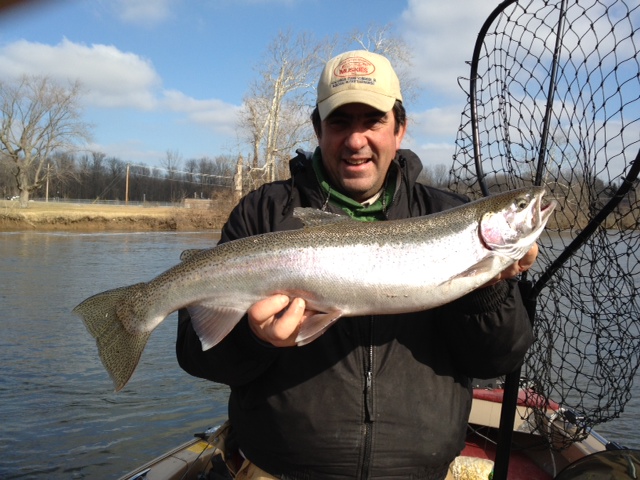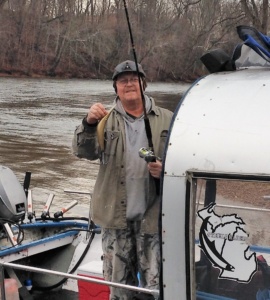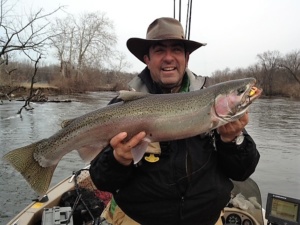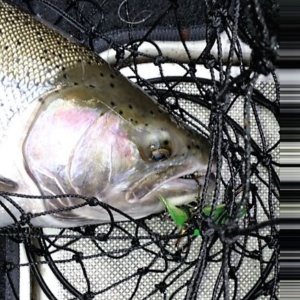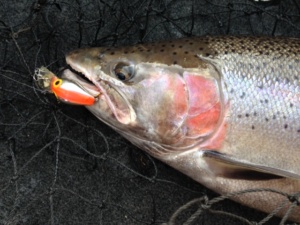Lure and Color Selection for River Steelhead
Capt. Niedlinger’s Philosophy
In the 70’s, my brother Gil and I began shore fishing the St. Joseph River in southwest Michigan in the fall for salmon and trout. The king salmon run was incredibly strong back then and anglers lined the banks of the river, elbow to elbow below the Berrien Springs dam. It was a frenetic scene with a sort of organized chaos. As a newbie to fishing for anadromous fish, I was astounded at the size, the number, and the variety of the species being landed. In addition to the big kings, there were steelhead and lake trout along with the occasional coho salmon and brown trout. It took a while to figure out the protocol; casting hardware was not compatible with straight drifting. Accordingly, one side of the river was dedicated to drifting and the other to casting hardware. If a hardware caster intervened between the drifters, tangled lines and frayed tempers could result. However, for the most part, anglers were tolerant and cooperative in the tight quarters, making for a quality fishing experience. Eventually we garnered a modicum of success and with such an initiation, a passion for pursuing these big-motor fish of salt water origin grew within us.
As the weather continued to cool and the salmon died off, the crowds thinned and fall run steelhead became the target of the hardiest of holdout bank anglers. There were also numerous charter captains working the river from enclosed and heated river boats. We saved our money until we were able to book a charter with one of these captains. We somehow fell into the company of Capt. Richard Niedlinger and his boat, the Silver King. We have not been the same since.
Walking and deadsticking spawn was a part of the routine and is still the primary technique used by most charter captains plying the river today. However, while most captains would deploy at best one plug on each side of their anchored boat while walking spawn, Capt. Niedlinger would deploy six or more plugs, pull his anchor, and backtroll. This required extraordinary skill because backtrolling is not easily done from inside the cabin while using a steering wheel. Backtrolling (aka river slipping) was his backup plan and was very effective, often producing vicious strikes. The plugs he used were foreign to me at the time. He favored a spectrum of offerings: Flatfish, Tadpollys, Wiggle Warts, Wee Warts, and Hot ‘n Tots were his weapons of choice. What they had in common was they all had an aggressive, hunting action that aggravated sometimes sullen salmon and steelhead into striking and they were all in metallic finishes.
Rich used basically only four finishes, regardless of the plug. These were gold with black back, gold with fluorescent orange back, silver with black back, and silver with fluorescent orange back. Under low or diffused light, such as early or late in the day, overcast skies or slightly murky water, Rich favored the gold finishes. Under bright light, such as midday sunshine or clear water, he favored the silver finishes. Both the black back and the orange back versions were deployed until a preference was shown by the fish. On one occasion, we fished the river under high, dirty water conditions and he used metallic red with black back Hot ‘n Tots which produced some big, mid-teen steelies. The trend was, with abundant light and clear water, he used silver. As the available light was reduced by cloud cover or water color, the darker metallic shades were employed. I have used this basic framework ever since with good success, although I also like to try fluorescent finishes under dirty water conditions.
There are a lot of factors that affect lure selection. Current speed, water depth, water temperature, water level, and water color along with using a gut feeling are all considerations. Although Rich never actually divulged his thought process regarding lure selection criteria to me, here are some guidelines I use.
In slower water, I prefer to use Flatfish because they produce an exaggerated action, even with reduced flow. T-4 and U-20 size Flatfish can be troublesome to tune to run properly in high current situations but using the versions with spreader bars and 4 treble hooks helps to make them more stable. Properly tuned, they can dive to about 12 feet or so, depending on line out. Half ounce Hot ‘n Tots have a wide hunting action which is great for triggering aggressive strikes but can also be troublesome in high current situations. They tend to run deep (in excess of 15 feet, depending on line length) and are at their best in moderate currents and deeper holes. Quarter ounce Hot ‘n Tots are more stable, they hunt less and don’t dive as deeply. They can be run in faster, shallower conditions. Tadpollys have a similar action to the Flatfish but are far more stable. They don’t dive as deeply as the larger Hot ‘n Tots or even the Flatfish but can be used in faster water.
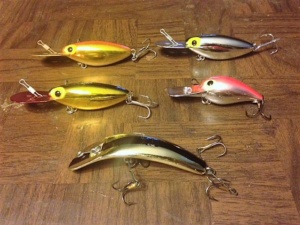
Some Productive Steelhead Plugs in Key Finishes Top Row: 1/2 ounce Hot ‘n Tots, Gold/Orange and Silver/Black Middle Row: 1/2 ounce Hot ‘n Tot, Gold/Black; Wiggle Wart, Silver/Orange Bottom: T-4 Flatfish with spreader bars, Gold/Black
That brings us to the Wart family. There were originally four sizes: the Mag Wart, the Wiggle Wart, the Wee Wart, and the Pee Wee Wart. However, when Normark bought the Storm Lure Company, they discontinued the Wee and Pee Wee models. Fortunately, Brad’s Killer Fishing Gear has stepped up and now produces their own versions, called Brad’s Wigglers. The Warts all have an internal rattle system (as do some Tadpolly and Hot ‘n Tot models). These lures have a fair amount of hunting action yet are quite stable once properly tuned. They dive from 5 to 20+ feet, depending on the model and line out (the larger, the deeper). They are at their best in moderate to fast current.
In low, clear water, I like to use smaller lures like Pee Wee and Wee Wigglers, especially if the water temperature is above 50 degrees. As the water temperature approaches freezing, it seems like it takes larger, more active plugs to wake them out of a stupor. In high stained water, I like using larger plugs with rattles like the Mag Wart although the larger Hot ‘n Tots also throw a lot of vibration into the water, which helps the fish hone in on the lure. The toughest condition is high, dirty, and cold water. When confronting this situation, staying home is one option although anchoring in reduced current areas near the bank and deploying spawn is another.
There are a myriad of variables that confront the fisherman each time we wet a line. By observing and asking questions of accomplished anglers, we can add some new tricks to our bag. This can shorten the learning curve and provide a framework to help sort through these variables. Using the criteria outlined above has worked for me over the years and can work for you too. I purposefully have not gone into detail about the finer points of river backtrolling in this article. That is a subject for another time.
Tight Lines!
Capt. Guy Lopez
January 21, 2017

